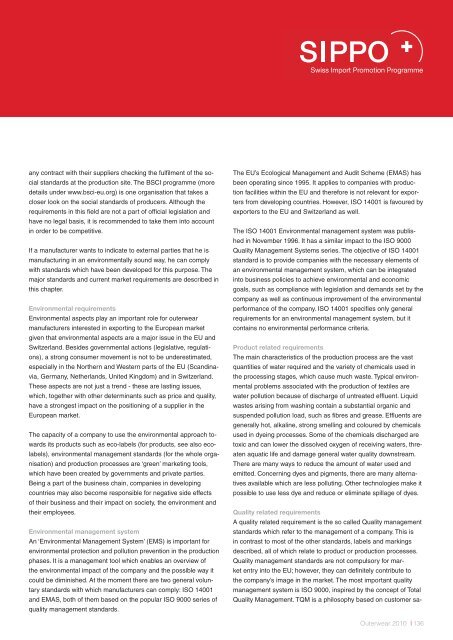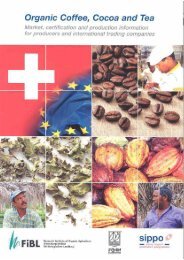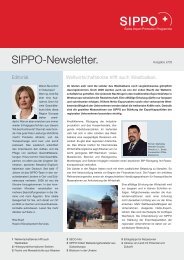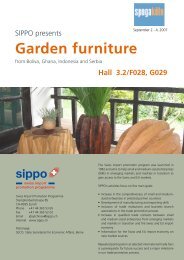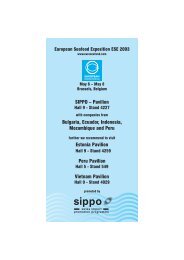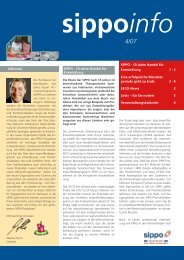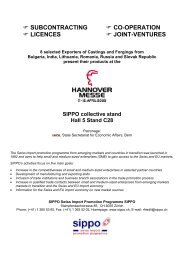Outerwear. - Business Location Switzerland
Outerwear. - Business Location Switzerland
Outerwear. - Business Location Switzerland
You also want an ePaper? Increase the reach of your titles
YUMPU automatically turns print PDFs into web optimized ePapers that Google loves.
any contract with their suppliers checking the fulfilment of the social<br />
standards at the production site. The BSCI programme (more<br />
details under www.bsci-eu.org) is one organisation that takes a<br />
closer look on the social standards of producers. Although the<br />
requirements in this field are not a part of official legislation and<br />
have no legal basis, it is recommended to take them into account<br />
in order to be competitive.<br />
If a manufacturer wants to indicate to external parties that he is<br />
manufacturing in an environmentally sound way, he can comply<br />
with standards which have been developed for this purpose. The<br />
major standards and current market requirements are described in<br />
this chapter.<br />
Environmental requirements<br />
Environmental aspects play an important role for outerwear<br />
manufacturers interested in exporting to the European market<br />
given that environmental aspects are a major issue in the EU and<br />
<strong>Switzerland</strong>. Besides governmental actions (legislative, regulations),<br />
a strong consumer movement is not to be underestimated,<br />
especially in the Northern and Western parts of the EU (Scandinavia,<br />
Germany, Netherlands, United Kingdom) and in <strong>Switzerland</strong>.<br />
These aspects are not just a trend - these are lasting issues,<br />
which, together with other determinants such as price and quality,<br />
have a strongest impact on the positioning of a supplier in the<br />
European market.<br />
The capacity of a company to use the environmental approach towards<br />
its products such as eco-labels (for products, see also ecolabels),<br />
environmental management standards (for the whole organisation)<br />
and production processes are ‘green’ marketing tools,<br />
which have been created by governments and private parties.<br />
Being a part of the business chain, companies in developing<br />
countries may also become responsible for negative side effects<br />
of their business and their impact on society, the environment and<br />
their employees.<br />
Environmental management system<br />
An ‘Environmental Management System’ (EMS) is important for<br />
environmental protection and pollution prevention in the production<br />
phases. It is a management tool which enables an overview of<br />
the environmental impact of the company and the possible way it<br />
could be diminished. At the moment there are two general voluntary<br />
standards with which manufacturers can comply: ISO 14001<br />
and EMAS, both of them based on the popular ISO 9000 series of<br />
quality management standards.<br />
The EU’s Ecological Management and Audit Scheme (EMAS) has<br />
been operating since 1995. It applies to companies with production<br />
facilities within the EU and therefore is not relevant for exporters<br />
from developing countries. However, ISO 14001 is favoured by<br />
exporters to the EU and <strong>Switzerland</strong> as well.<br />
The ISO 14001 Environmental management system was published<br />
in November 1996. It has a similar impact to the ISO 9000<br />
Quality Management Systems series. The objective of ISO 14001<br />
standard is to provide companies with the necessary elements of<br />
an environmental management system, which can be integrated<br />
into business policies to achieve environmental and economic<br />
goals, such as compliance with legislation and demands set by the<br />
company as well as continuous improvement of the environmental<br />
performance of the company. ISO 14001 specifies only general<br />
requirements for an environmental management system, but it<br />
contains no environmental performance criteria.<br />
Product related requirements<br />
The main characteristics of the production process are the vast<br />
quantities of water required and the variety of chemicals used in<br />
the processing stages, which cause much waste. Typical environmental<br />
problems associated with the production of textiles are<br />
water pollution because of discharge of untreated effluent. Liquid<br />
wastes arising from washing contain a substantial organic and<br />
suspended pollution load, such as fibres and grease. Effluents are<br />
generally hot, alkaline, strong smelling and coloured by chemicals<br />
used in dyeing processes. Some of the chemicals discharged are<br />
toxic and can lower the dissolved oxygen of receiving waters, threaten<br />
aquatic life and damage general water quality downstream.<br />
There are many ways to reduce the amount of water used and<br />
emitted. Concerning dyes and pigments, there are many alternatives<br />
available which are less polluting. Other technologies make it<br />
possible to use less dye and reduce or eliminate spillage of dyes.<br />
Quality related requirements<br />
A quality related requirement is the so called Quality management<br />
standards which refer to the management of a company. This is<br />
in contrast to most of the other standards, labels and markings<br />
described, all of which relate to product or production processes.<br />
Quality management standards are not compulsory for market<br />
entry into the EU; however, they can definitely contribute to<br />
the company’s image in the market. The most important quality<br />
management system is ISO 9000, inspired by the concept of Total<br />
Quality Management. TQM is a philosophy based on customer sa-<br />
<strong>Outerwear</strong> 2010 l 136


